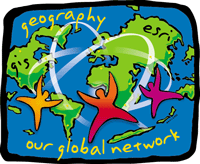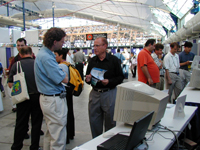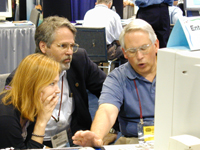|
The Magazine for
Esri Software Users |
|
|||
Conference Focuses on the Global Network
The biggest GIS show on earth--the 20th Annual Esri International User Conference--drew more than 9,500 GIS users from all over the world to San Diego for five days of learning, sharing, and fun. Those attending this conference could choose from more than 700 paper presentations in 38 categories and hundreds of technical workshops on Esri software programs as well as participate in fun events such as a 5K Run/Walk and tennis and golf tournaments. Bringing Information TogetherThe growth in conference attendance has mirrored the explosive growth of GIS in recent years as it has become a mainstream information technology. More than two million people working in government, business, and academic spheres use GIS to gain a better understanding of their world. As Esri President Jack Dangermond observed in his address during the opening session, "GIS is successful not only because it integrates data but it enables us to share data in different departments or segments of our organizations. It helps us integrate these specializations, bringing information together--not just data but our organizations and people. I like this notion of putting the world's pieces back together again."
Integration is the key concept behind the new single environment of ArcGIS, which debuted at the conference. With ArcGIS, users learn one interface, one development environment, and one set of tools and can be productive in any of the software programs built with this robust and scalable system. The development of this technology supports the growing trend of GIS awareness and adoption by governments, businesses, and individuals. Events such as GIS Day, slated for November 15, 2000, have helped the public appreciate how GIS contributes to the operation of everything from agriculture to emergency response. Our Global NetworkThe conference theme, "Geography Our Global Network," was underscored by the introduction of the Geography Network--a new way for people to learn more about their world. Made possible by ArcIMS, a revolutionary new Internet map serving technology that is part of ArcGIS, the Geography Network gives users immediate access to the latest maps, data, and related services and lets them view data from many different sources. The Geography Network is a community of organizations and individuals that share the common goal of using geographic information to make better decisions. Using geographic information for decision support was the theme of the conference's keynote address by Dr. Charles G. Groat. "Doing good science is not enough. It has to be effective in the community," declared the director of the United States Geological Survey (USGS). Dr. Groat, director of the USGS since 1998, has had a distinguished career working in the earth science community. His address focused on the role of science in a rapidly changing world. He stressed that effective decision making will be enhanced by integrating what is learned through science with other types of knowledge. Sites such as the Geography Network build on the work of the National Spatial Data Infrastructure (NSDI) in providing standards and technology that let citizens access data. The USGS has made the National Elevation Dataset (NED) available through the Geography Network. In creating NED, the USGS merged the highest-resolution, best quality data together to form a seamless raster elevation model of the United States. Recognizing AchievementsThe User Conference is not only a time for previewing new GIS technologies and trends but also an occasion for recognizing the achievements of leaders in this industry. Phil Lewis was honored with a Lifetime Achievement Award. In his speech during the plenary session, Lewis, whose encouragement convinced Jack Dangermond to pursue his dream of founding a computer mapping company, reflected on a career that has spanned more than 50 years. Lewis said his goal has been to try to "guide human patterns in harmony with the life-sustaining ones." Also onstage to receive accolades on the conference's opening day were students from Barrington Middle School of Barrington, Rhode Island, and their teacher, Lyn Malone. They were recognized for their outstanding work on the Community Atlas project. Later in the week, 150 users from all over the world were honored with Special Achievement in GIS awards. Recipients are listed in another article in this issue. In addition to honoring outstanding users and pioneers in the GIS industry, Esri received an award. During the plenary session, Pam Johnson, deputy director for the National Partnership for Reinventing Government, presented Esri and six teams from the NSDI Community Demonstration Project with Hammer Awards. The teams honored were
Each project illustrated the benefits of sharing geographic information between federal and local agencies. Esri contributed $500,000 in software, training, technical support, and services to program participants. Quoting Yogi Berra, baseball Hall of Fame catcher and fractured philosopher, Johnson observed, "The future just ain't what it used to be." The six organizations receiving Hammer Awards demonstrated the important role geography will have in creating the government of the future-a government informed by geography.
Exchanging Ideas and InformationThe User Conference was started 20 years ago to gather the GIS community in one place at one time so that Esri could get feedback directly from users, and users could learn more about GIS from Esri and each other. Though the conference has grown in length and includes many events, this continues to be the major focus. Through paper presentations, numerous special interest group meetings, and informal gatherings over lunch or chance encounters in the convention center halls, GIS users shared their expertise, made connections with others in the field, and learned about the latest trends in GIS at this year's conference. | |||||||||||||||


